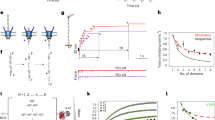Abstract
MUSCLE contraction is generally thought to be driven by tilting1, 2 of the 19-nm-long myosin head3, part of the thick filament, while attached to actin, part of the thin filament. This motion would produce about 12 nm of filament sliding4, 5. Recent estimates of the sliding distance per ATP molecule hydrolysed by actomyosin in vitro vary widely from 8 nm (ref. 6) to >=200 nm (ref. 7). The latter value is incompatible with a power stroke incorporating a single tilting motion of the head. We have measured the isotonic sliding distance per ATP molecule hydrolysed during the interaction between myosin and actin in skinned muscle fibres. We directly estimated the proportion of simultaneously attached actomyosin complexes and their ATP use. We report here that at low loads the interaction distance is at least 40 nm. This distance corresponds to the length of the power stroke plus the filament sliding while actomyosin crossbridges bear negative drag forces5, 8. If the power stroke is 12 nm, then our results indicate the drag distance to be at least 28 nm. Our results could also be explained by multiple power strokes per ATP molecule hydrolysed.
This is a preview of subscription content, access via your institution
Access options
Subscribe to this journal
Receive 51 print issues and online access
$199.00 per year
only $3.90 per issue
Buy this article
- Purchase on Springer Link
- Instant access to full article PDF
Prices may be subject to local taxes which are calculated during checkout
Similar content being viewed by others
References
Reedy, M. K., Holmes, K. C. & Tregear, R. T. Nature 207, 1276–1280 (1965).
Huxley, H. E. Science 164, 1356–1366 (1969).
Elliott, A. & Offer, G. J. molec. Biol. 123, 505–519 (1978).
Huxley, A. F. & Simmons, R. M. Nature 233, 533–538 (1971).
Ford, L. E., Huxley, A. F. & Simmons, R. M. J. Physiol. 269, 441–515 (1977).
Toyoshima, Y. Y., Kron, S. J. & Spudich, J. A. Proc. natn. Acad. Sci. U.S.A. 87, 7130–7134 (1990).
Harada, Y., Sakurada, K., Aoki, T., Thomas, D. D. & Yanagida, T. J. molec. Biol. 216, 49–68 (1990).
Huxley, A. F. Prog. Biophys. biophys. Chem. 7, 255–318 (1957).
Yanagida, T., Arata, T. & Oosawa, F. Nature 316, 366–369 (1985).
Uyeda, T. Q. P., Kron, S. J. & Spudich, J. A. J. molec. Biol. 214, 699–710 (1990).
Huxley, A. F. & Simmons, R. M. Cold Spring Harb. Symp. quant. Biol. 37, 669–680 (1973).
Ferenczi, M. A., Homsher, E. & Trentham, D. R. J. Physiol. 352, 575–599 (1984).
Cecchi, G., Colomo, F. & Lombardi, V. Boll. Soc. ital. biol. Sper. 52, 733–736 (1976).
Goldman, Y. E., Hibberd, M. G. & Trentham, D. R. J. Physiol. 354, 577–604: 605–624 (1984).
Goldman, Y. E. Biophys. J. 52, 57–68 (1987).
Tawada, K. & Kimura, M. Biophys. J. 45, 593–602 (1984).
Vale, R. D. & Oosawa, F. Adv. Biophys. 26, 97–134 (1990).
Lombardi, V. & Piazzesi, G. J. Physiol. 431, 141–171 (1990).
Ishijima, A., Doi, T., Sakurada, K. & Yanagida, T. Nature 352, 301–306 (1991).
Author information
Authors and Affiliations
Rights and permissions
About this article
Cite this article
Higuchi, H., Goldman, Y. Sliding distance between actin and myosin filaments per ATP molecule hydrolysed in skinned muscle fibres. Nature 352, 352–354 (1991). https://doi.org/10.1038/352352a0
Received:
Accepted:
Issue Date:
DOI: https://doi.org/10.1038/352352a0
This article is cited by
-
A myosin II nanomachine mimicking the striated muscle
Nature Communications (2018)
-
Electron microscopic recording of myosin head power stroke in hydrated myosin filaments
Scientific Reports (2015)
-
The stroke size of myosins: a reevaluation
Journal of Muscle Research and Cell Motility (2006)
-
A single myosin head moves along an actin filament with regular steps of 5.3 nanometres
Nature (1999)
-
How molecular motors work in muscle
Nature (1998)
Comments
By submitting a comment you agree to abide by our Terms and Community Guidelines. If you find something abusive or that does not comply with our terms or guidelines please flag it as inappropriate.



